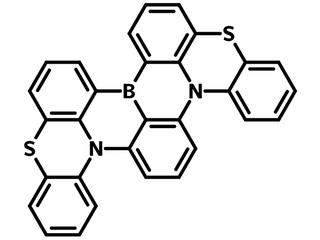2PTZBN
CAS Number 2250280-17-0
Dopant Materials, Green Dopant Materials, High Purity Sublimed Materials, Materials, MR-TADF Materials, OLED Materials,MR-TADF Green Dopant Material with Triarylboron
High purity sublimed narrowband MR-TADF emitter for highly efficient OLEDs, [1,4]Benzothiazino[4'',3'',2'':1',8'][1,4]benzazaborino[4',3',2':4,5][1,4]benzazaborino[3,2,1-kl]phenothiazine, BN3, PTZ-BN, CAS No. 2250280-17-0, Sublimed ≥99.0%
Specifications | MSDS | Literature and Reviews
2PTZBN is a multi-resonance thermally activated delayed fluorescence (MR-TADF) green emitter with a DABNA-1 triarylboron core. Two heavy sulfur atoms opposite to the nitrogen atoms are embedded to bridge the the peripheral phenyl rings to form even more rigid structure. By fusing the non-metal sulfur atoms into the multi-resonance B-N framework, it can accelerate the rate of reverse intersystem crossing (RISC) process of the emitter up to 2.8 × 105 s-1 in toluene due to larger spin-orbital coupling (SOC) values and smaller singlet-triplet energy splitting (ΔEST) while compared with the oxygen incorporated green MR-TADF emitter 2PXZBN (PXZ-BN).
OLED device based on 2PTZBN as the active layer dopant and DMIC-TRZ as the host demonstrates maximum EQE of 34.6% with low turn-on voltage below 2.5 V and extremely high luminance over 100,000 cd m-2.
General Information
| CAS Number | 2250280-17-0 |
|---|---|
| Chemical Formula | C30H17BN2S2 |
| Molecular Weight | 480.41 g/mol |
| Absorption* | λmax 471 nm (in toluene) |
| Fluorescence | λem 510 nm (in toluene) |
| HOMO/LUMO | HOMO = - 5.19 eV, HOMO = - 2.73 eV; ΔEST = 0.15 eV [1] |
| Synonyms | PTZ-BN, BN3, [1,4]Benzothiazino[4'',3'',2'':1',8'][1,4]benzazaborino[4',3',2':4,5][1,4]benzazaborino[3,2,1-kl]phenothiazine |
| Classification or Family | Phenothiazine derivatives, Triarylboron, Green dopant, Multiresonance thermally activated delayed fluorescent (MR-TADF), Sublimed materials. |
Product Details
| Purity | Sublimed* >99% (HPLC) |
|---|---|
| Melting Point | Td = 392 °C |
| Appearance | Orange powder/crystals |
* Sublimation is a technique used to obtain ultra pure-grade chemicals, see sublimed materials for OLED devices.
Chemical Structure

Device Structure(s)
| Device structure | ITO/HAT-CN, 5 nm/TAPC, 30 nm/mCBP, 10 nm/1 wt.% 2PTZBN:DMIC-TRZ, 50 nm/POT2T, 20 nm/ANT-BIZ, 30 nm/Liq, 2 nm/Al, 100 nm [1] |
|---|---|
| Color |
 Green, 520 nm Green, 520 nm |
| CIE Coordinates | (0.24, 0.67) |
| Max Current Efficiency | 124.9 cd/A |
| Max Power Efficiency | 157.7 lm/W |
| Max EQE | 34.6% |
| Device structure | ITO/HAT-CN (5 nm)/TAPC (30 nm)/mCP (10 nm)/mCBP:PO-T2T:2PTZBN (49.5:49.5:1) (20 nm)/PO-T2T (10 nm)/TmPyPB (40 nm)/Liq (1.5 nm)/Al (100 nm) [2] |
|---|---|
| Color |
 Green, 528 nm Green, 528 nm |
| CIE Coordinates | (0.28, 0.65) |
| FWHM | 58 nm |
| Max Luminescence | 16,720 cd m-2 |
| Max Current Efficiency | 96.5 cd/A |
| Max Power Efficiency | 86.6 lm/W |
| Max EQE | 25.5% |
MSDS Documentation
Literature and Reviews
- Y. Hu et al. (2022); Efficient selenium-integrated TADF OLEDs with reduced roll-off, Nat. Photon., 16, 803–810; DOI: 10.1038/s41566-022-01083-y.
- T. Hua et al. (2021); Heavy-atom effect promotes multi-resonance thermally activated delayed fluorescence, Chem. Eng. J. 426, 131169; DOI: 10.1016/j.cej.2021.131169.
